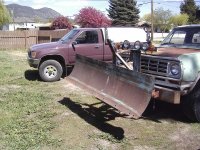Jay4200
Veteran Member
- Joined
- Nov 23, 2005
- Messages
- 2,028
- Location
- Hudson/Weare, NH
- Tractor
- L4200GST w/ LA680 & BX2200D w/ LA211
I have a piece of town plow cutting edge that I plan to weld onto my bucket to make a new cutting edge. I am going to weld it directly to what little is left of the original welded cutting edge, placing the new material under the old then welding around the edges. The suggestion I have so far is to gap the new edge slightly below the old edge (like 1/16") to prevent cracking. Then burn in the first weld at 200A using 6011, then top with a more normal 125A or so using 7018. I heard a similar suggestion from another welder for technique, but the rod type was reversed - so one of them was confused. I have 6011 and 7018 rods ready to go, however, I don't know which to use when.
Any suggestions and/or recommendations are welcome.
Thanks - JayC
Any suggestions and/or recommendations are welcome.
Thanks - JayC
